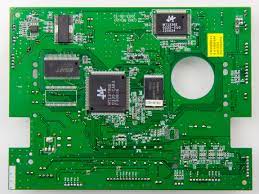Printed circuit boards, or PCBs, are the backbone of many electronic products and devices. They serve as a foundation for mounting components like capacitors, resistors, transistors and other electrical components — all while keeping them from shorting out one another.
Copper
Copper is a great electrical conductor. It’s been used in all electronics, and it’s also the only thing that can be used for printed circuit board assembly (PCBA). Since copper conducts electricity so well, all cables and connectors are made of copper, as well as wires going into the board itself.
Glass epoxy
Glass epoxy is a thermoset polymer, meaning it’s made of molecules that are permanently cross-linked. This gives glass epoxy its hardness and brittleness. Glass epoxy consists of two components: an epoxide resin and a hardener. The resin serves as the base material, while the hardener provides it with strength and rigidity.
When combined together, these two compounds form a solid material that’s used as an insulator in PCBs (printed circuit boards). It also protects copper traces from corrosion.
Silkscreen ink
Silkscreen ink is used to add text and graphics to the PCB. It is also used as a solder mask, which is a layer of protection on both sides of the board. The silkscreen ink is applied using a silk screen with resist material that protects exposed copper from etching by acids during chemical milling of the board surface.
Adhesives
Adhesives are used to hold the components in place and bond layers together. They can also be used to attach the PCB board to other PCB boards or materials such as its outer casing.
Some common adhesives include: epoxy, phenolic, urethane, acrylic resins, silicone rubber, hot-melt adhesives (HMA), thermoplastic polymer (TPU), hydrogenated castor oil waxes and epichlorohydrin reaction products
Solder mask
Solder mask is a layer of material that protects the copper traces and pads on the surface of printed circuit boards (PCBs). It prevents short circuits, corrosion, and oxidation. On top of that, it also helps to identify where components can be connected to each other.
The most common solder mask used in PCBs is glass epoxy; however, some manufacturers use different types depending on their needs. Silkscreen ink is generally used as a solder mask because it provides good adhesion with minimal risk of lifting up as well as excellent thermal performance in high/low temperature environments. Adhesives are used to hold components in place during assembly so they don’t move when you apply heat during soldering processes!
Metal substrate
The substrate is the base of your PCB assembly board, and it can be composed of several different materials. The most common substrates are copper-clad laminate (CCL), FR4, TG130, TG150, and TG180. Each one has its own advantages and disadvantages, which I’ll discuss below:
- Copper-clad laminate (CCL) – CCL is a material that consists of two layers: a thin layer of epoxy resin that acts as an insulator between two thin sheets of copper foil bonded together. It’s commonly used for high-frequency circuits because its low dielectric constant makes it ideal for high-speed inductors or capacitors.
- FR4 – FR4 stands for “fiberglass reinforced epoxy,” which simply refers to how much fiberglass is included in the epoxy resin matrix in this type of substrate material. It’s typically used as an economical alternative to other substrates such as CCL because it provides similar electrical performance at lower costs than other options like gold-plated versions
Conclusion
After reading this blog post, you should have a better understanding of what PCB (printed circuit board) boards are made of and their purpose in our lives. We hope that after reading this article you feel inspired to go out and make something awesome!
